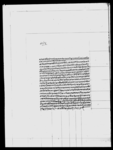A report from Lokaramaṇa Upādhyāya to Māthavara Siṃha Thāpā on political developments in Sindhia after the Gwalior campaign of 1843 (VS 1900)
ID: DNA_0004_0036
Edited and
translated by Manik Bajracharya, Simon Cubelic, Rajan Khatiwoda
Created: 2016-11-30;
Last modified: 2018-06-25
For the metadata of the document, click here
The accompanying edition, translation/synopsis and/or commentary are available under the terms of the Creative Commons Attribution-ShareAlike 4.0 International License
Abstract
Lokaramaṇa Upādhyāya provides a detailed and accurate overview of the provisions of the peace treaty between the Company Government and Gwalior state after the hostilities of the year 1843.Diplomatic edition
[1r]
1⟪नं३७५⟫1स्वस्तिश्रीसर्वोपमाजोग्यत्यादिसकलगुणालंकृतराजभारोद्धारनसामर्थजनरलसाहेवश्री2श्रीश्रीजनरलमातवरसिंहथापामाहासयषु¯ ¯ ¯ ¯ ¯ ¯ ¯ ¯ ¯ ¯ ¯ ¯ ¯ ¯ ¯ ¯ ¯ ¯ ¯ ¯ ¯ ¯ ¯
3श्रीलोकरमनोपाध्यायकोवेदोक्तसुभआसिर्वादउप्रान्तवाइसदिनलाठसाहेवग्वालि
4यरमारह्यायस्मा२०हजारराषिअरूसवैसिँधियाकोफौजऔपल्टन्रिसालागैह्र
5लाठसाहेवलेमौकुफ्गर्यामौकुफगर्याकाफौजकावदलामाकंपनिकोफौजकन्टिल्
6जंटिकापल्टनहरूररिसालाग्वालियरमाराषन्यावंदोवस्तगर्याउसषर्चदर्माहानिमि
7त्तभाडेर१कछुव़ाधार१वदेरि१हडियाहर्दा१सहारनपुर१सुजातपुर१जाव़द१इ
8सातजगामा१४लाषरूपैञाआमदानिहुन्याअंग्रेजहरूलेझिकिलियाअघिवैजावा
9इसितझगडाहुदाकंपनिकोषर्चपर्याको११लाषरूपैञाहाललडाइहुदाषर्चभया
10को१५लाषरूपैञाज्मा२६लाषरूपैञाग्वालियरकाषजानावाटलाठसाहेववाटन
11गदटोडालिग्वालियकोराज्यजस्तोअघिथियोवहालगर्यारामराव़वावाफालकेला
12इकामदारिमावहालगरिउनमनिभाउपोतनिसगैह्रलाइराष्याअघिकाकामदार
13मामासाहेवभन्याकालाइग्वालियरडाकन्यासलाहभयनयतिवंदोवस्तलेषपढभैला
14ठसाहेवग्वालियरवाटकुँचगरिसेव़धाभन्याकाजगावुदेलषंडगयाव़ाहावुदेलषं
15डकाराजाहरूसितमुलाकातगरिकालपिवाटडाकमासव़ारभैकलकत्ताआ
16व़न्याछन्वुदेलषंडकारजिडंटकासाथमाझासिकादेव़ानकाछोराग्वपालराव़
17लाठसाहेवकासाथग्वालियरगयाकाथियाउनकावावुवाटचिठिपठाउनलाइनि
18स्तुरषवरमगाइविन्तिलेष्याकोछअघिपनिवारंवारदर्माहाकोविन्तिचह्राइपठाया
19कोछजवापकेहिआयनषामिंदिफर्माइदर्माहाकोनिकासागरिवक्सनुभयाया
20हारिनकर्जाहरूतिरिज्यूवचाउन्यापाठगर्दाहुंचरनमाकलकत्ताकोहव़ालसवजा
21हेरैछइतिसम्वत्१९००सालमितिफागुनवदि७रोज७शुभम्¯ ¯ ¯ ¯ ¯ ¯ ¯ ¯ ¯ ¯ ¯ ¯ ¯
Translation
[1r]
Number 3751
Hail! To the thrice venerable General Māthavara Siṃha Thāpā, the magnanimous one who is adorned with all [superior] qualities—the worthiness [to be an object] of all [exalted] similes and the like—and who is able to shoulder royal duties.
Auspicious blessings from Lokaramaṇa Upādhyāya as uttered in the Vedas .
Uprānta: Lord (lāṭhā) sāhaba2 remained in Gwalior for twenty-two days. Keeping 20,000 [troops] there, Lord sāhaba disbanded all of Sindhia's armies, battalions, cavalries and so forth.3 Instead of the armies that were disbanded, he arranged to place in Gwalior armies of the Company and battalion and cavalry of the contingent force (kaṇṭiljaṃṭi).4 For the expenses and monthly salaries [relating to] this, the English raised 14 lakh rupees as revenue in the following seven places: Bhāḍera, Kachuvādhāra, Vaḍeri, Haḍiyāhardā, Sahāranapura, Sujātapura, and Jāvada.5 The 11 lakh rupees that arose as costs to the Company during the dispute with Baijā Bāi earlier,6 and the 15 lakh rupees that have arisen in the current war—in total 26 lakh rupees of cash and valuables—Lord sāhaba took from the Gwalior treasury [but] kept the kingdom of Gwalior as it was before.7 He retained Rām Rāo Bābā Phālke8 as kāmadāra [of Gwalior state] and placed persons such as Bhāu Potanisa9 under him. There were no suggestions to call the former kāmadāra named Māmā Sāheba10 [back] to Gwalior. Having arranged all this and other paperwork, Lord sāhaba left Gwalior and hastened to a place called Sevadhā11 in Budelakhaṃḍa. There, once he has met with the kings of Budelakhaṃḍa, he will come to Calcutta from Kālapi12 by post coach. Gopāla Rāo, the son of the devāna of Jhansi,13 had gone to Gwalior with the resident of Budelakhaṃḍa14 and Lord sāhaba. His father (i.e., Bhāu Potanisa) has written requesting that factual (?)15 tidings be sent so that [he] will write a letter.16
Earlier, too, a request for [my] salary has been sent from time to time. No reply has come. If you, compassionate as you are, released [my] salary, I would save my life by clearing [my] debts here. To [your] feet the condition of Calcutta is already known. Saturday, the 7th of the dark fortnight of Phālguna in the [Vikrama] era year 1900 (1844 CE). Auspiciousness.
Commentary
In this letter, Lokaramaṇa Upādhyāya provides a detailed and to all appearances accurate overview of the provisions of the peace treaty between the Company Government and Gwalior state after the hostilities of the year 1843. The conflict between the two parties arose when an anti-British faction at the court of Gwalior prevailed and started to assert Gwalior's autonomy (Farooqui 2007: 54-55), taking advantage of British military setbacks during the First Anglo-Afghan War. During the late 1830s Nepal had tried to re-establish diplomatic ties with Sindhia in order to win her over for an anti-British alliance (cf. Mojumdar 1973: 33-34).

